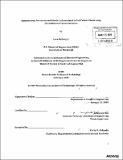Immunoassay sensitivity and kinetic enhancement in cell culture media using electrokinetic preconcentration
Author(s)
Li, Leon Daliang
DownloadFull printable version (47.67Mb)
Other Contributors
Massachusetts Institute of Technology. Dept. of Electrical Engineering and Computer Science.
Advisor
Jongyoon Han.
Terms of use
Metadata
Show full item recordAbstract
The microfluidic cell culture enables the study of cell signaling in previously impossible or impractical ways by allowing the precise spatial and temporal control of the microenvironment to better mimic in vivo conditions. Microfluidic techniques allow the creation of exact culture geometries, cell patterns, and the use of perfusion techniques to precisely control external soluble factor signaling and effectively inhibit autocrine signaling factors. To date, microfluidic techniques have been used to perform single cell analyses, generate molecular gradients, and pattern three-dimensional cultures. The task of identifying and quantifying the cell culture proteome from cell lysate or the secreted proteins is often performed by the immunoassay. Macroscale immunoassays such as those performed on the tissue culture plate, however, are of limited use for the microfluidic cell culture due to the limited volume of sample generated by the microfluidic culture. The ability to precisely patterning cells on the microscale (10-100um) enables cell study at physiological length scales, but also drastically reduces both the sample volume and the protein abundance when compared to the tissue culture plate. Due to these twin challenges of low sample volume and low secreted protein concentration, the detection of protein antigens by immunoassay on many microfluidic cell cultures applications is currently practically infeasible. To address the limitations of low sample volume and low protein concentration, we have developed a novel microscale immunoassay device capable of the electrokinetic concentration of proteins. This technique allows us to improve the sensitivity of immunoassays through increasing the antigen concentration prior to antibody-antigen binding, or preconcentration. Using this scheme, we have demonstrated a 100 fold sensitivity improvement for antigens directly from cell media without sample preparation when compared with immunoassays without preconcentration. (cont.) Our immunoassay also benefits from sub microliter required sample volume and may be easily integrated directly to microfluidic cell cultures. Furthermore, we fabricated micro electrodes integrated on chip to the electrokinetic preconcentrator to directly measure the electric field which accompanies nonlinear electrokinetic flow. The time response electrical profiles of electrokinetic preconcentration was obtained and correlated to the protein concentration profile to study electrokinetic behavior. Our efforts yielded a method to directly visualize the electric field distribution in nonlinear electrokinetic flow and a direct relationship between the depletion effects of electrokinetic behavior and the electric field profile.
Description
Thesis (S.M.)--Massachusetts Institute of Technology, Dept. of Electrical Engineering and Computer Science, 2009. Includes bibliographical references (p. 39-42).
Date issued
2009Department
Massachusetts Institute of Technology. Department of Electrical Engineering and Computer SciencePublisher
Massachusetts Institute of Technology
Keywords
Electrical Engineering and Computer Science.